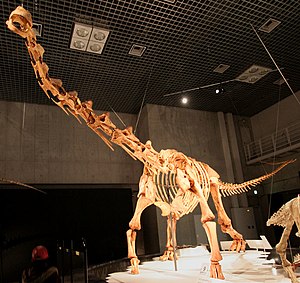Maxakalisaurus
| Maxakalisaurus | ||||||||||||
|---|---|---|---|---|---|---|---|---|---|---|---|---|

Skeletal reconstruction of Maxakalisaurus topai |
||||||||||||
| Temporal occurrence | ||||||||||||
| Upper Cretaceous ( Campanium or Maastrichtium ) | ||||||||||||
| 83.6 to 66 million years | ||||||||||||
| Locations | ||||||||||||
| Systematics | ||||||||||||
|
||||||||||||
| Scientific name | ||||||||||||
| Maxakalisaurus | ||||||||||||
| Kellner et al. , 2006 | ||||||||||||
| Art | ||||||||||||
|
Maxakalisaurus is a genus of sauropod dinosaurs from the Titanosauria group . So far, only a single fragmentary skeleton is known from the late Upper Cretaceous Brazil . The only species is Maxakalisaurus topai .
features
Maxakalisaurus , like all sauropods, was characterized by a barrel-shaped body with a long neck and tail. Comparisons with related, better-known genera suggest a medium-sized sauropod about 13 meters long. However, the fragile bones of the only previously known skeleton suggest that this individual was not yet fully grown when it died.
Like several other titanosaurs, Maxakalisaurus possessed osteoderms (cutaneous bone plates), as suggested by the discovery of a single, incomplete osteoderm near the skeleton. This osteoderm is 10.5 inches long, 8.4 inches wide, 6.2 inches thick, and elliptical in shape. The top of this bone is strongly convex and decorated with small bumps and pits. Titanosaur osteoderms are always found either individually or in very few specimens, which is why some researchers suspect that titanosaurs generally carried only a few osteoderms. In the opinion of these researchers, a possible function of the osteoderms as armor appears questionable because a small number of osteoderms would not have represented an effective defense against predators .
Maxakalisaurus can be distinguished from related genera by the dorsoventrally flattened anterior and middle caudal vertebrae and a fourth metacarpal, which was 12% shorter than the second metacarpal.
Systematics
The relationships of Maxakalisaurus within the Titanosauria are unclear. The cervical vertebrae suggest that this genus was more derived (modern) than Isisaurus and Mendozasaurus . A very derived group of titanosaurs were the Saltasaurinae , with which Maxakalisaurus shows a common feature (flattened caudal vertebrae). However, in other characteristics Maxakalisaurus differs from the Saltasaurinae. Researchers led by Alexander Kellner are therefore provisionally listing this genus as the sister taxon of the Saltasaurinae.
Santucci and colleagues (2011) come to the conclusion that Maxakalisaurus is to be classified within the Aeolosaurini , together with Panamericansaurus , Rinconsaurus , Gondwanatitan and Aeolosaurus . Here are maxakalisaurus , rinconsaurus and panamericansaurus basal (original) members of this group, while aeolosaurus and gondwanatitan were derived (advanced) representative.
History of discovery and naming
The only known skeleton was recovered during four excavations that the National Museum of Campina Verde carried out in 1998, 2000, 2001 and 2002. The site is located 45 kilometers west of the city of Prata in the Brazilian state of Minas Gerais .
The bones were found spread over an area of 40 square meters. Although most of the bones were found to be inarticulate (unrelated), some cervical and caudal vertebrae were partially recovered. The researchers assume that almost all bones belonged to the same individual; However, this assumption cannot be proven. However, there is no evidence that the bones were transported by water before they were embedded, which is why it is assumed that the bones are in situ . Three bones of the shoulder girdle overlap with other of the discovered bones and may therefore have belonged to another Maxakalisaurus individual. The bones show signs of weathering and are partially broken. In addition to the bones of the remaining skeleton, which mainly include vertebrae, shoulder bones and some leg bones, there was also part of an upper jaw including teeth. Together with the Maxakalisaurus fossils, isolated theropod and crocodile-like teeth as well as the remains of turtles were found. The bones were recovered from a layer of fine to medium-grained reddish sandstone overlying a layer of conglomerates . These rocks indicate that Maxakalisaurus lived in a semi-arid climate with seasonal dry and rainy seasons. These deposits are part of the Adamantina Formation , which belongs to the Bauru Group .
The genus was scientifically described for the first time in 2006 by researchers working with Alexander Kellner . The genus name refers to the Maxakalí , an indigenous people who live in the state of Minas Gerais , where the remains of the sauropod were found in the Adamantina formation . The specific epithet topai is derived from the name of one of their deities.
Individual evidence
- ^ Gregory S. Paul : The Princeton Field Guide To Dinosaurs. Princeton University Press, Princeton NJ et al. 2010, ISBN 978-0-691-13720-9 , p. 212, online .
- ↑ a b c d e f g Alexander WA Kellner, Diogenes de Almeida Campos, Sergio AK de Azevedo, Marcelo NF Trotta, Deise DR Henriques, Maureen MT Craik, Helder de Paula Silva: On a new titanosaur sauropod from the Bauru Group, Late Cretaceous of Brazil. In: Boletim do Museu Nacional. Geologia. No. 74, 2006, ISSN 0080-3200 , pp. 1–31, online (PDF; 3.31 MB) ( Memento from March 15, 2007 in the Internet Archive ).
- ↑ Michael D. D'Emic, Jeffrey A. Wilson, Sankar Chatterjee : The titanosaur (Dinosauria: Sauropoda) osteoderm record: review and first definitive specimen from India. In: Journal of Vertebrate Paleontology. Vol. 29, No. 1, 2009, pp. 165-177, doi : 10.1671 / 039.029.0131 .
- ↑ Jeffrey A. Wilson, Dhananjay M. Mohabey, Shanan E. Peters, Jason J. Head: Predation upon Hatchling Dinosaurs by a New Snake from the Late Cretaceous of India. In: PLoS Biol . Vol. 8, No. 3, 2010, e1000322, doi : 10.1371 / journal.pbio.1000322 .
- ↑ Rodrigo M. Santucci, Antonio C. de Arruda-Campos. A new sauropod (Macronaria, Titanosauria) from the Adamantina Formation, Bauru Group, Upper Cretaceous of Brazil and the phylogenetic relationships of Aeolosaurini. In: Zootaxa . Vol. 3085, 2011, pp. 1–33, digital version (PDF; 2.09 MB) .
Web links
- Michael Astor: Brazil's Biggest Dinosaur Unveiled. August 29, 2006, accessed May 6, 2013 .
